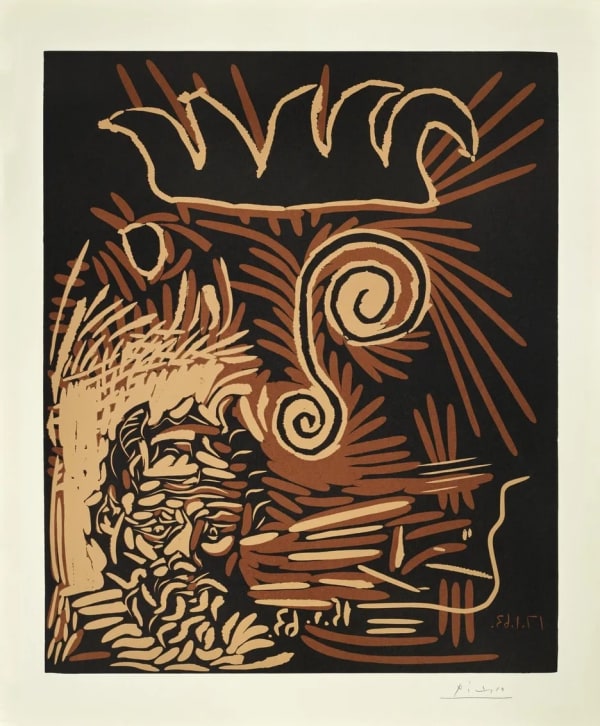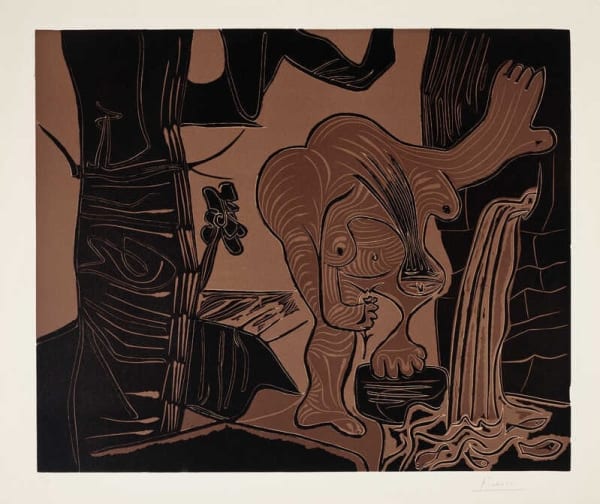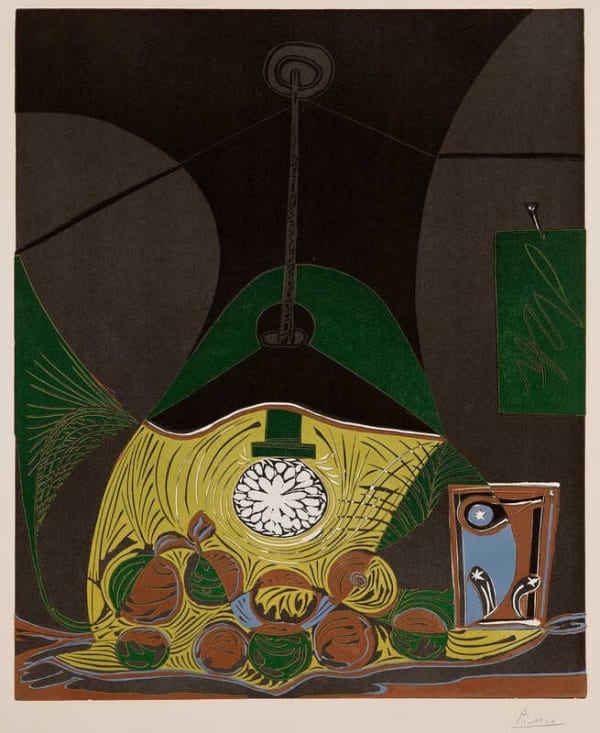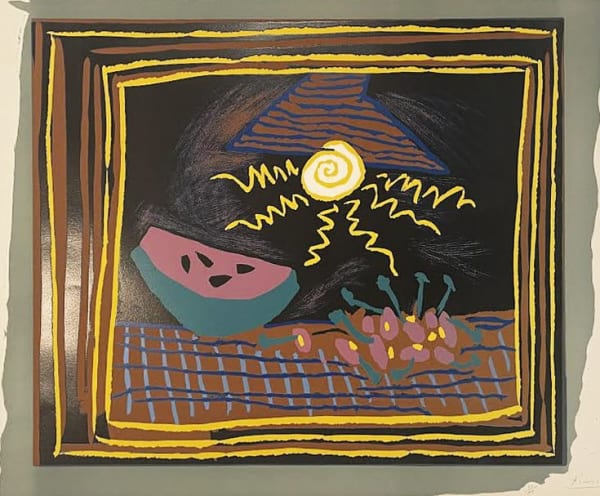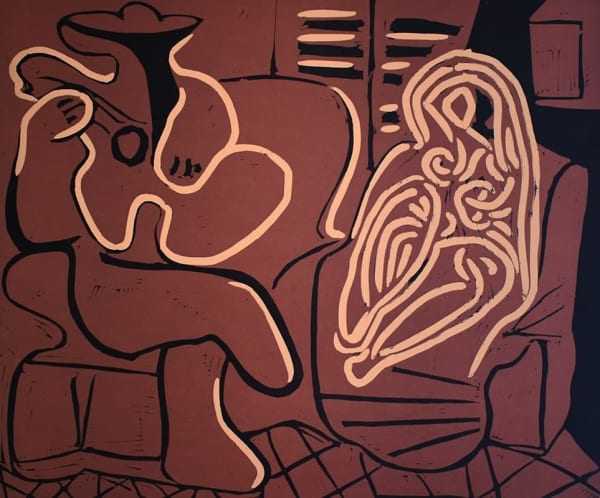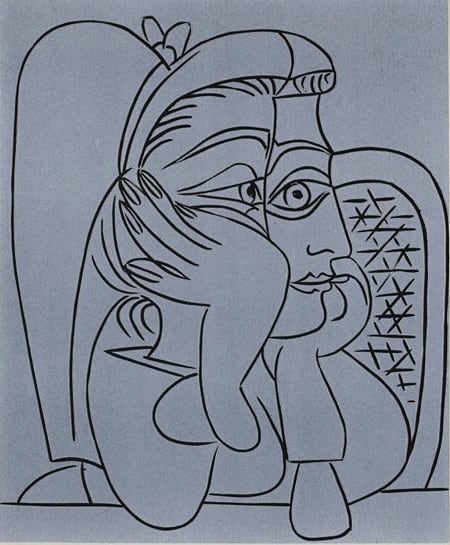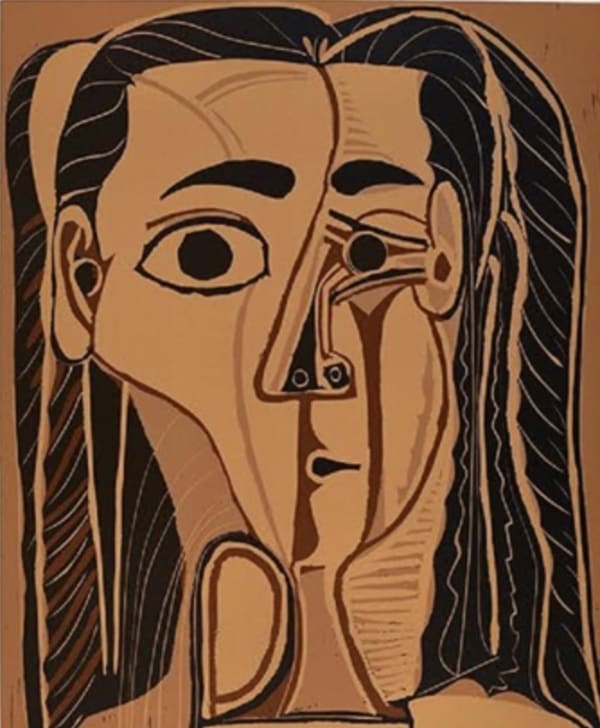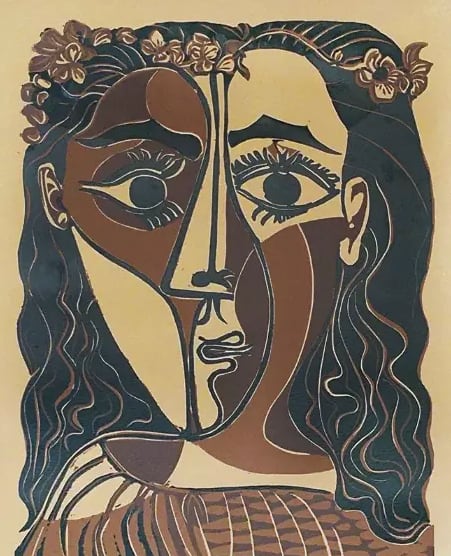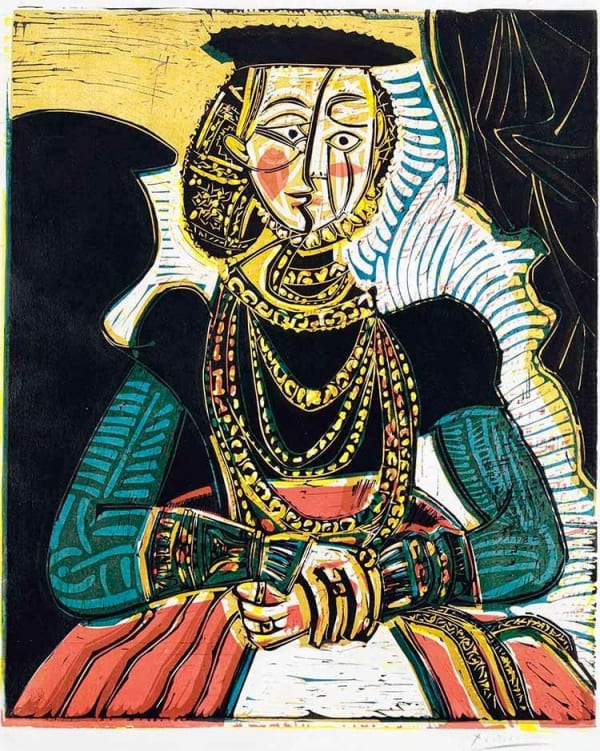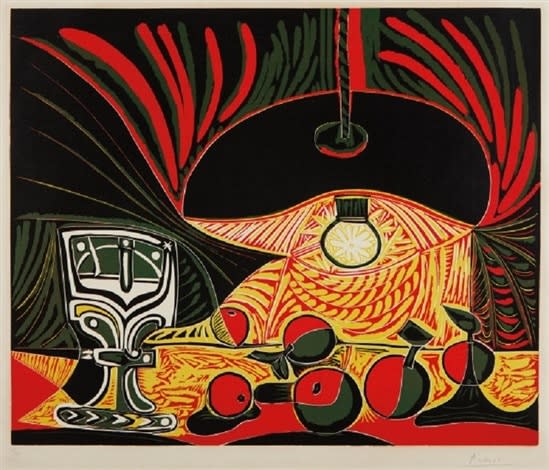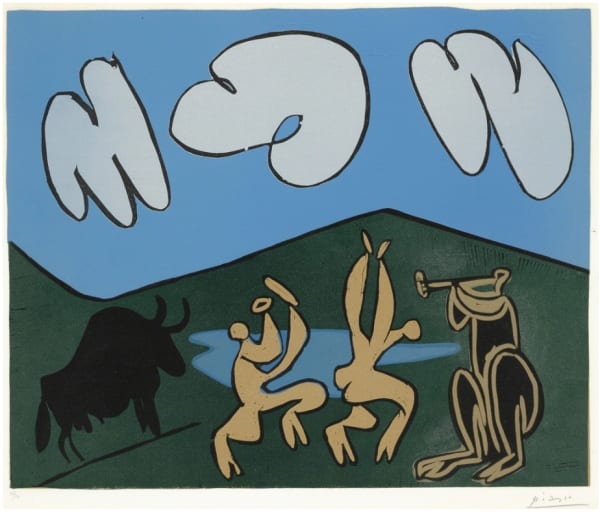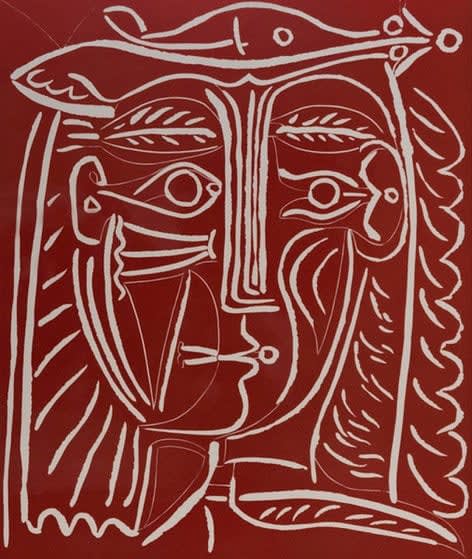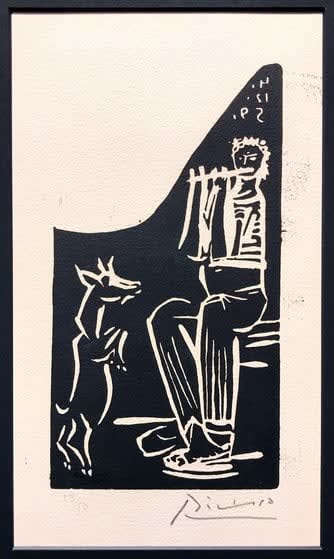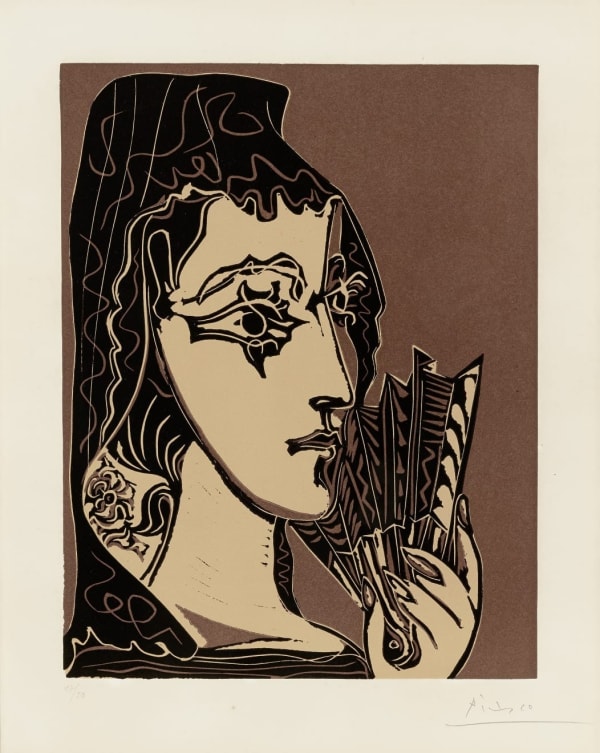
Pablo Picasso
Hand signed in black pencil in lower right margin
74.9 x 62.2 cm
This artwork is Pablo Picasso’s La Pique en Rouge et Jaune (The Bullfight in Red and Yellow), 1959, a linocut that reflects both his technical mastery of the medium and his lifelong fascination with bullfighting. It is one of the most powerful examples of his late linocuts, where Picasso distilled complex themes into bold, simplified forms of color and line.
The composition is dominated by vivid red and yellow, colors that evoke both the Spanish flag and the fiery atmosphere of the bullring. Within this field of abstraction, figures emerge: the charging bull, the picador with his lance, and swirling forms that capture the chaos and ritualized violence of the corrida.
Picasso reduces the scene to dynamic silhouettes, allowing the viewer to sense the movement and energy rather than follow literal detail. The circular arc at the top recalls the shape of the arena, framing the struggle within a symbolic stage. The intertwining of bodies—both human and animal—expresses the tension between life, death, and spectacle that defines the bullfight.
Created as a linocut, this work showcases Picasso’s inventive use of the reduction method, where successive layers of color are cut and printed from the same block. This process left no room for error, requiring absolute precision and forethought. The stark contrast between the red and yellow planes exemplifies his ability to use the medium’s limitations as a source of expressive power.
The simplicity of the palette heightens the drama: yellow becomes light and vitality, red becomes blood, passion, and danger. Together, they transform the image into a symbolic drama rather than a literal scene.
Bullfighting held immense cultural and symbolic significance for Picasso, who saw it as a reflection of life’s fundamental struggles—creation versus destruction, beauty versus brutality, ritual versus chaos. For him, the corrida was not merely sport but a metaphor for art itself: an arena where the artist, like the matador, confronts danger and mortality, transforming violence into spectacle and meaning.
In La Pique en Rouge et Jaune, the use of Spain’s national colors deepens this cultural resonance, binding the subject to national identity and tradition. The bull, a symbol of strength, fertility, and primal force, is here both victim and aggressor—an embodiment of nature’s power and man’s attempt to dominate it.
This work thus becomes more than a depiction of bullfighting: it is a meditation on passion, mortality, and the eternal dance between man, beast, and fate.
La Pique en Rouge et Jaune (The Bullfight in Red and Yellow), 1959, is a linocut by Pablo Picasso depicting a bullfight in stark, abstracted forms of red and yellow. Using the reduction method, Picasso creates a powerful interplay of figures, color, and movement, evoking the energy and ritual of the corrida. The bull, central to Spanish culture and symbolic of primal power, becomes both subject and metaphor, embodying the themes of life, death, and artistic creation. The work exemplifies Picasso’s mastery of linocut and his ability to transform cultural tradition into a universal, modernist vision.
For more information or to buy La Pique en Rouge et Jaune (The Bullfight in Red and Yellow), by Pablo Picasso, contact our galleries using the form below.-
 Pablo PicassoTwo Women by the Window | Deux femmes près de la fenêtre, 1959
Pablo PicassoTwo Women by the Window | Deux femmes près de la fenêtre, 1959 -
 Pablo PicassoWoman Reclining and Man with a Guitar | Femme couchée et homme à la guitare, , 1959
Pablo PicassoWoman Reclining and Man with a Guitar | Femme couchée et homme à la guitare, , 1959 -
 Pablo PicassoJacqueline au chapeau de paille, 1962
Pablo PicassoJacqueline au chapeau de paille, 1962 -
 Pablo PicassoLe Vieux bouffon, 1963
Pablo PicassoLe Vieux bouffon, 1963 -
 Pablo PicassoHomme au batôn / Le Vieux bouffon, 1963
Pablo PicassoHomme au batôn / Le Vieux bouffon, 1963 -
 Pablo PicassoFemme nue à la source, 1963
Pablo PicassoFemme nue à la source, 1963 -
 Pablo PicassoNature morte à la suspension, 26 mars, 1962
Pablo PicassoNature morte à la suspension, 26 mars, 1962 -
 Pablo PicassoTaureau et Picador, 1959
Pablo PicassoTaureau et Picador, 1959 -
 Pablo PicassoFemme au Chapeau (Portrait de Jacqueline au chapeau de paille multicolore)., 1962
Pablo PicassoFemme au Chapeau (Portrait de Jacqueline au chapeau de paille multicolore)., 1962 -
 Pablo PicassoLe Déjeuner sur l'herbe d'aprés Edouard Manet. (The Luncheon on the Grass after Edouard Manet), 1954
Pablo PicassoLe Déjeuner sur l'herbe d'aprés Edouard Manet. (The Luncheon on the Grass after Edouard Manet), 1954 -
 Pablo PicassoBoy with a Crown of Leaves | Jeune homme couronné de feuillage, 1959
Pablo PicassoBoy with a Crown of Leaves | Jeune homme couronné de feuillage, 1959 -
 Pablo PicassoLe Vieux Roi (B. 1152) (The Old King) , 1963
Pablo PicassoLe Vieux Roi (B. 1152) (The Old King) , 1963 -
 Pablo PicassoNature Morte a la Pasteque, 1962
Pablo PicassoNature Morte a la Pasteque, 1962 -
 Pablo PicassoAubade, with a Woman in an Armchair | L'aubade, avec femme dans un fauteuil, 1959
Pablo PicassoAubade, with a Woman in an Armchair | L'aubade, avec femme dans un fauteuil, 1959 -
 Pablo PicassoL'Aubade, avec Femme Accoudee, 1959
Pablo PicassoL'Aubade, avec Femme Accoudee, 1959 -
 Pablo PicassoLes vendangeurs, 1959
Pablo PicassoLes vendangeurs, 1959 -
 Pablo PicassoFemme Accoudée (Bloch 922) , 1959
Pablo PicassoFemme Accoudée (Bloch 922) , 1959 -
 Pablo PicassoGrande Tete De Femme (Bloch 1069), 1962
Pablo PicassoGrande Tete De Femme (Bloch 1069), 1962 -
 Pablo PicassoPetite Tête de Femme Couronnée, `962
Pablo PicassoPetite Tête de Femme Couronnée, `962 -
 Pablo PicassoBuste de Femme d'après Cranach le Jeune, (Bloch 859), 1958
Pablo PicassoBuste de Femme d'après Cranach le Jeune, (Bloch 859), 1958 -
 Pablo PicassoPortrait de Jacqueline Accoudée, 1959
Pablo PicassoPortrait de Jacqueline Accoudée, 1959 -
 Pablo PicassoJacqueline au Bandeau, 1962
Pablo PicassoJacqueline au Bandeau, 1962 -
 Pablo PicassoNature Morte Au Verre Sous La Lampe, 1962
Pablo PicassoNature Morte Au Verre Sous La Lampe, 1962 -
 Pablo PicassoPortrait de Jacqueline Au Chapeau De Paille Fleuri, 1962
Pablo PicassoPortrait de Jacqueline Au Chapeau De Paille Fleuri, 1962 -
 Pablo PicassoNu Assis, 1962
Pablo PicassoNu Assis, 1962 -
 Pablo PicassoPortrait De Jacqueline (Bloch 923), 1959
Pablo PicassoPortrait De Jacqueline (Bloch 923), 1959 -
 Pablo PicassoJacqueline au Bandeau, 1962
Pablo PicassoJacqueline au Bandeau, 1962 -
 Pablo PicassoWatermelon Still Life, 1962
Pablo PicassoWatermelon Still Life, 1962 -
 Pablo PicassoDeux Femmes Prés de la Fenêtre , 1959
Pablo PicassoDeux Femmes Prés de la Fenêtre , 1959 -
 Pablo PicassoBacchanale au Hibou (bloch 938), 1959
Pablo PicassoBacchanale au Hibou (bloch 938), 1959 -
 Pablo PicassoBacchanale au Taureau Noir (Bloch 935), 1959
Pablo PicassoBacchanale au Taureau Noir (Bloch 935), 1959 -
 Pablo PicassoTête de Femme au Chapeau , 1962
Pablo PicassoTête de Femme au Chapeau , 1962 -
 Pablo PicassoFaune et Chévre, 1959
Pablo PicassoFaune et Chévre, 1959 -
 Pablo PicassoPortrait de Femme a la Fraise et au Chapeau , 1962
Pablo PicassoPortrait de Femme a la Fraise et au Chapeau , 1962 -
 Pablo PicassoL'Etreinte (Bloch 1150), 1963
Pablo PicassoL'Etreinte (Bloch 1150), 1963 -
 Pablo PicassoPortrait de Jacqueline en Carmen (L'Espagnole) , 1962
Pablo PicassoPortrait de Jacqueline en Carmen (L'Espagnole) , 1962
Join our mailing list
* denotes required fields
We will process the personal data you have supplied in accordance with our privacy policy (available on request). You can unsubscribe or change your preferences at any time by clicking the link in our emails.
This website uses cookies
This site uses cookies to help make it more useful to you. Find out more about cookies.



